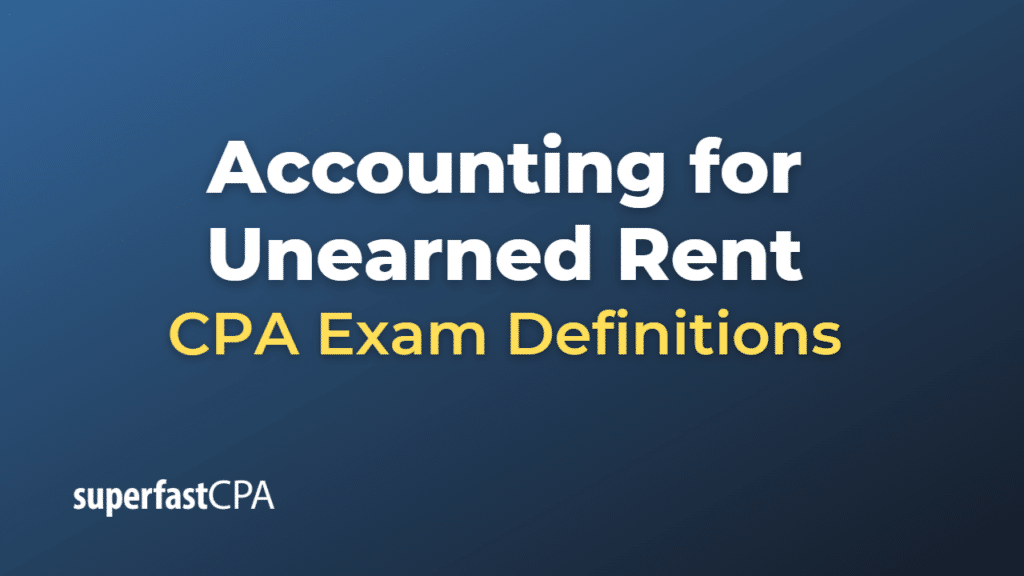Accounting for Unearned Rent
Accounting for unearned rent involves the identification, recognition, measurement, and disclosure of rent payments received by a company in advance for the use of its property or assets. Unearned rent is a type of deferred revenue, representing an obligation for the company to provide the use of its property or assets over a future period.
Under U.S. Generally Accepted Accounting Principles (GAAP), accounting for unearned rent is primarily governed by the Financial Accounting Standards Board (FASB) Accounting Standards Codification (ASC) Topic 606, “Revenue from Contracts with Customers.
Here are the key aspects of accounting for unearned rent:
- Identification: Determine if a rent payment received by a company qualifies as unearned rent. Unearned rent typically arises when a company receives rent payments in advance for the use of its property or assets over a future period.
- Recognition: Unearned rent should be recognized as a liability in the financial statements when it is received, as it represents an obligation for the company to provide the use of its property or assets over a future period.
- Measurement: Unearned rent should be measured at the amount received from the tenant, which is typically stated in the rental agreement.
- Amortization: As the rental period progresses and the company fulfills its obligation to provide the use of its property or assets, the unearned rent liability should be reduced, and the corresponding rent revenue should be recognized in the income statement. This process is called amortization, and it should be done on a systematic basis, typically using a straight-line method over the rental period.
- Presentation: Unearned rent should be presented as a liability in the balance sheet, often under current liabilities if the rental period is less than one year or under non-current liabilities if the rental period is longer than one year. Rent revenue should be presented in the income statement as part of the company’s operating revenues.
- Disclosure: Companies should provide clear and concise information about their accounting policies for unearned rent in the notes to the financial statements. This may include information about the nature of the rental agreements, the periods covered by the unearned rent, and the methods used to amortize the unearned rent.
By properly accounting for unearned rent, a company provides users of its financial statements with an accurate representation of its financial position and performance, considering the rent payments received in advance and the company’s obligations to provide the use of its property or assets over a future period.
Example of Accounting for Unearned Rent
Let’s consider an example of a company accounting for unearned rent.
Example: Company XYZ owns a commercial building and rents out office space to various tenants. On January 1, Company XYZ signs a 1-year lease agreement with Tenant A. Tenant A agrees to pay $12,000 in rent for the year, with the full amount due upfront on January 1.
Here’s how Company XYZ would account for the unearned rent:
Step 1:
Identification: The rent payment received by Company XYZ qualifies as unearned rent, as it is received in advance for the use of office space over the future 1-year period.
Step 2:
Recognition: Company XYZ recognizes the unearned rent as a liability in its financial statements when it receives the $12,000 payment on January 1.
Step 3:
Measurement: Unearned rent is measured at the amount received from Tenant A, which is $12,000.
Step 4:
Amortization: Company XYZ amortizes the unearned rent over the 1-year rental period using a straight-line method. Each month, the company reduces the unearned rent liability by $1,000 ($12,000 / 12 months) and recognizes $1,000 in rent revenue in its income statement.
Step 5:
Presentation: Unearned rent is presented as a current liability in the balance sheet since the rental period is less than one year. Rent revenue is presented in the income statement as part of the company’s operating revenues.On January 1, the balance sheet would show:
| Current Liabilities: |
| Unearned Rent: $12,000 |
After 3 months (on March 31), the balance sheet would show:
| Current Liabilities: |
| Unearned Rent: $9,000 |
And the income statement for the 3 months ended March 31 would show:
| Revenues: |
| Rent Revenue: $3,000 |
Step 6:
Disclosure: Company XYZ provides information about its accounting policies for unearned rent in the notes to the financial statements, including the nature of the rental agreements, the periods covered by the unearned rent, and the methods used to amortize the unearned rent.
By properly accounting for unearned rent, Company XYZ provides users of its financial statements with an accurate representation of its financial position and performance, considering the rent payments received in advance and the company’s obligations to provide the use of its property or assets over a future period.













